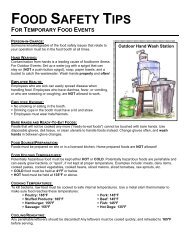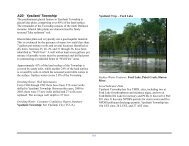Water Protection Activities in Washtenaw County
Water Protection Activities in Washtenaw County
Water Protection Activities in Washtenaw County
You also want an ePaper? Increase the reach of your titles
YUMPU automatically turns print PDFs into web optimized ePapers that Google loves.
2.1 Conditions and Trends<br />
The primary use of groundwater <strong>in</strong> <strong>Washtenaw</strong> <strong>County</strong> is to<br />
supply dr<strong>in</strong>k<strong>in</strong>g water. Well water is the only water source<br />
available to <strong>County</strong> residents that do not fall <strong>in</strong>to a community<br />
water system. With the exception of the service are of Ann<br />
Arbor, which draws approximately 15% of its water from the<br />
ground and the portions of the <strong>County</strong> served by the City of<br />
Detroit <strong>Water</strong> and Sewer Department, all of <strong>Washtenaw</strong><br />
<strong>County</strong>’s community water systems are sourced by<br />
groundwater. See Section 4.0 for <strong>in</strong>formation on the <strong>in</strong>dividual<br />
water systems (Figures 2 and 3).<br />
Groundwater <strong>in</strong> <strong>Washtenaw</strong> <strong>County</strong> has many components<br />
other than H2O. Some are naturally occurr<strong>in</strong>g, like iron and<br />
calcium (“Hardness”), and some are the result of<br />
contam<strong>in</strong>ation, like Volatile Organic Compounds (VOCs)<br />
which are typically components of petroleum products. In<br />
addition, there are some substances that can be found <strong>in</strong> the<br />
water supply that may be both naturally occurr<strong>in</strong>g or the result<br />
of contam<strong>in</strong>ation, such as nitrates and heavy metals.<br />
Some of the substances found <strong>in</strong> the water pose no health risk,<br />
but are a nuisance because of their taste, sight, or smell. Iron,<br />
for <strong>in</strong>stance, will sta<strong>in</strong> plumb<strong>in</strong>g fixtures. Hardness, tann<strong>in</strong>s,<br />
and manganese do not cause health effects but may have other<br />
effects that are undesirable; hardness causes scal<strong>in</strong>g of water<br />
fixtures and soap scum, tann<strong>in</strong>s cause a yellow discoloration,<br />
and manganese causes a bad taste and can sta<strong>in</strong> cloth<strong>in</strong>g.<br />
5<br />
Some substances that may pose a health risk are virtually<br />
undetectable by taste, sight and smell. Nitrates, arsenic, and<br />
lead are all examples of dangerous substances that may be <strong>in</strong><br />
<strong>Washtenaw</strong> <strong>County</strong> well water that are physically undetectable.<br />
There are other substances that may pose a health risk that are<br />
more likely to be detected because of an adverse smell or taste.<br />
Methane and hydrogen sulfide gas, heavy metals, and VOCs<br />
may all be physically detectable and could pose a health risk.<br />
Bacteria can also possess an odor; however, it is not likely to<br />
be detectable <strong>in</strong> small amounts.<br />
Well owners with questions regard<strong>in</strong>g their dr<strong>in</strong>k<strong>in</strong>g water are<br />
encouraged to contact the <strong>Washtenaw</strong> <strong>County</strong> Department of<br />
Plann<strong>in</strong>g and Environment Development Services Division at<br />
(734) 222-3800. A sanitarian can provide specific <strong>in</strong>formation<br />
on well test<strong>in</strong>g services available and make suggestions for<br />
tests that address issues unique to each home owner’s well.
















